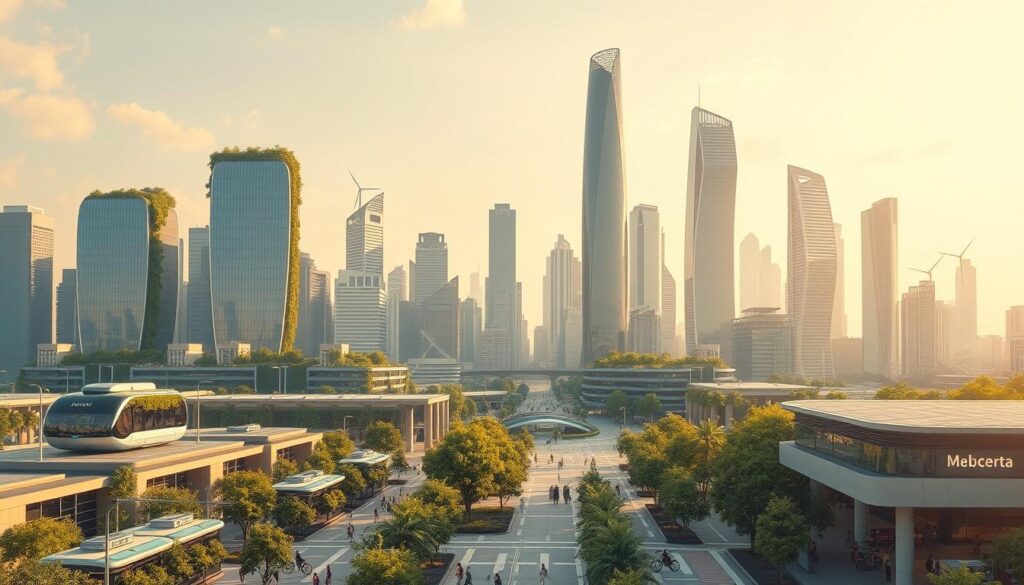The United Nations Environment Programme (UNEP) highlights that significant investment in sustainable infrastructure development is crucial to achieving the Sustainable Development Goals and net-zero emissions. As the world grapples with climate change, the need for eco-friendly development has become more pressing than ever.
The construction industry is one of the largest consumers of natural resources and a significant contributor to greenhouse gas emissions. However, by adopting sustainable building materials and practices, we can reduce environmental impact and create a more resilient future.
Key Takeaways
- The need for sustainable infrastructure is critical to achieving net-zero emissions.
- Eco-friendly development can significantly reduce environmental impact.
- Adopting sustainable building materials is crucial for a greener future.
- Infrastructure development plays a significant role in climate change.
- Investing in sustainable infrastructure can lead to a more resilient world.
Understanding Sustainable Infrastructure Development
In the face of growing environmental concerns, sustainable infrastructure development has emerged as a vital strategy for cities worldwide. As urban populations continue to grow, the need for infrastructure that supports economic growth while minimizing environmental impact becomes increasingly pressing.
Definition and Importance
Sustainable infrastructure integrates economic growth with ecological responsibility and social inclusivity. It focuses on long-term durability, minimizing carbon footprints, and optimizing resource efficiency. According to the United Nations, sustainable infrastructure is crucial for achieving the Sustainable Development Goals (SDGs), particularly SDG 9, which focuses on industry, innovation, and infrastructure.
“Sustainable infrastructure is not just about reducing environmental impact; it’s also about creating economic opportunities and improving the quality of life for communities,” says an expert in sustainable urban planning.
Key Principles of Sustainability
The key principles of sustainability in infrastructure development include:
- Minimizing environmental impact through green technologies and practices
- Ensuring social equity by providing access to resources and services for all community members
- Promoting economic viability through efficient use of resources and long-term planning
These principles guide the development of green infrastructure projects, which are designed to be environmentally sustainable and resilient.
Historical Context of Sustainable Development
The concept of sustainable development has evolved significantly over the decades. The Brundtland Commission’s report in 1987 marked a significant milestone, defining sustainable development as “meeting the needs of the present without compromising the ability of future generations to meet their own needs.”
Since then, the focus on sustainable infrastructure has grown, with cities around the world adopting sustainable urban planning practices to address climate change, urbanization, and social inequality.
Environmental Benefits of Sustainable Infrastructure
As the world grapples with climate change, sustainable infrastructure emerges as a key solution. The environmental benefits of adopting such infrastructure are multifaceted, contributing significantly to a healthier planet.
Reduction of Carbon Footprint
One of the most significant advantages of sustainable infrastructure is its ability to reduce carbon footprint. By transitioning to renewable energy infrastructure, such as solar and wind power, we can significantly decrease our reliance on fossil fuels, thereby lowering greenhouse gas emissions. Data indicates that infrastructure is responsible for a substantial portion of global emissions, both in operational energy use and embodied emissions through material usage.
The shift towards sustainable infrastructure not only involves the adoption of renewable energy sources but also the implementation of energy-efficient technologies and practices. For instance, green buildings that incorporate advanced insulation materials and smart energy management systems can drastically reduce energy consumption.
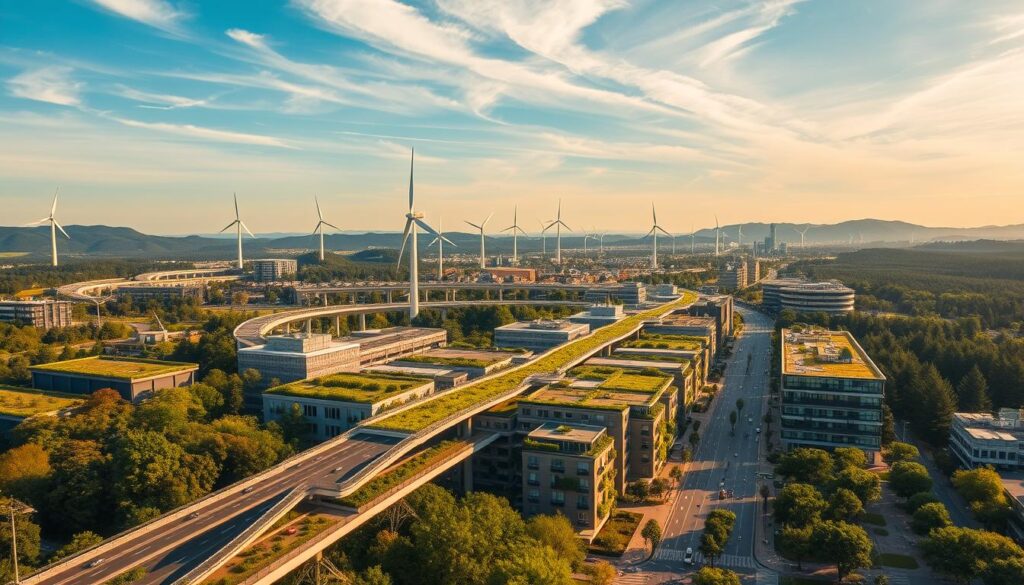
Preservation of Natural Resources
Sustainable infrastructure also plays a crucial role in the preservation of natural resources. By adopting climate-resilient infrastructure, we can protect ecosystems and biodiversity. This includes designing infrastructure that works in harmony with natural systems, rather than imposing on them. For example, restoring wetlands and floodplains can enhance natural water filtration and reduce the risk of flooding.
Moreover, sustainable infrastructure promotes the efficient use of water resources through advanced management systems and technologies. This is particularly important in regions facing water scarcity, where every drop counts.
Mitigation of Climate Change Effects
The mitigation of climate change effects is another critical benefit of sustainable infrastructure. By investing in infrastructure that is resilient to the impacts of climate change, such as sea-level rise and extreme weather events, we can protect communities and economies. This involves not just the construction of new infrastructure but also the retrofitting of existing structures to meet future climate challenges.
Furthermore, sustainable infrastructure can help in reducing the urban heat island effect through the use of green roofs, cool pavements, and other innovative urban design strategies. These measures not only improve the quality of life for urban residents but also contribute to a more sustainable urban environment.
In conclusion, the environmental benefits of sustainable infrastructure are profound and far-reaching. By reducing carbon footprint, preserving natural resources, and mitigating the effects of climate change, sustainable infrastructure is crucial for creating a more resilient and sustainable future.
Economic Advantages of Sustainable Infrastructure
The economic advantages of sustainable infrastructure are multifaceted and significant. Investing in green buildings, sustainable transportation systems, and sustainable construction practices not only benefits the environment but also boosts the economy. By adopting sustainable infrastructure, communities can experience significant economic growth.
Job Creation and Economic Growth
Sustainable infrastructure development fuels job creation in various sectors, including renewable energy, construction, engineering, and urban planning. According to recent data, the shift towards green energy alone has generated millions of new jobs globally. For more insights on sustainable infrastructure and its benefits, visit AMC Consult.
The creation of these jobs not only stimulates local economies but also contributes to national economic growth. As the demand for sustainable infrastructure continues to rise, so does the potential for employment opportunities in this sector.
Cost Savings Over Time
One of the significant economic advantages of sustainable infrastructure is the cost savings it offers over time. While the initial investment in sustainable infrastructure might be higher, the long-term benefits include reduced operational and maintenance costs. For instance, energy-efficient buildings consume less energy, leading to lower utility bills.
Moreover, sustainable infrastructure often requires less maintenance and has a longer lifespan compared to traditional infrastructure. This durability translates into cost savings for communities and businesses, as they spend less on repairs and replacements.
Long-term Investment Returns
Sustainable infrastructure also offers attractive long-term investment returns. As governments and private investors increasingly focus on sustainability, projects that incorporate green technologies and practices are becoming more lucrative. Investing in sustainable transportation systems, for example, can yield significant returns as these systems become integral to urban planning and development.
For further information on transportation network engineering and its role in sustainable infrastructure, you can refer to World Civil Society. The long-term economic benefits of such investments make sustainable infrastructure an attractive option for investors looking for stable and profitable opportunities.
Social Impacts of Sustainable Infrastructure
As cities continue to grow, the importance of sustainable infrastructure in fostering community well-being becomes increasingly evident. Sustainable infrastructure is designed not only to minimize environmental impacts but also to enhance the quality of life for urban residents.
Enhancing Community Well-being
Sustainable infrastructure directly contributes to community well-being by providing clean energy, reducing pollution, and improving urban mobility. For instance, sustainable infrastructure projects often incorporate green spaces, which have been shown to improve mental health and reduce stress levels among residents.
The implementation of sustainable energy solutions is a key aspect of enhancing community well-being. By transitioning to renewable energy sources, cities can significantly reduce air pollution, leading to healthier environments for their citizens.
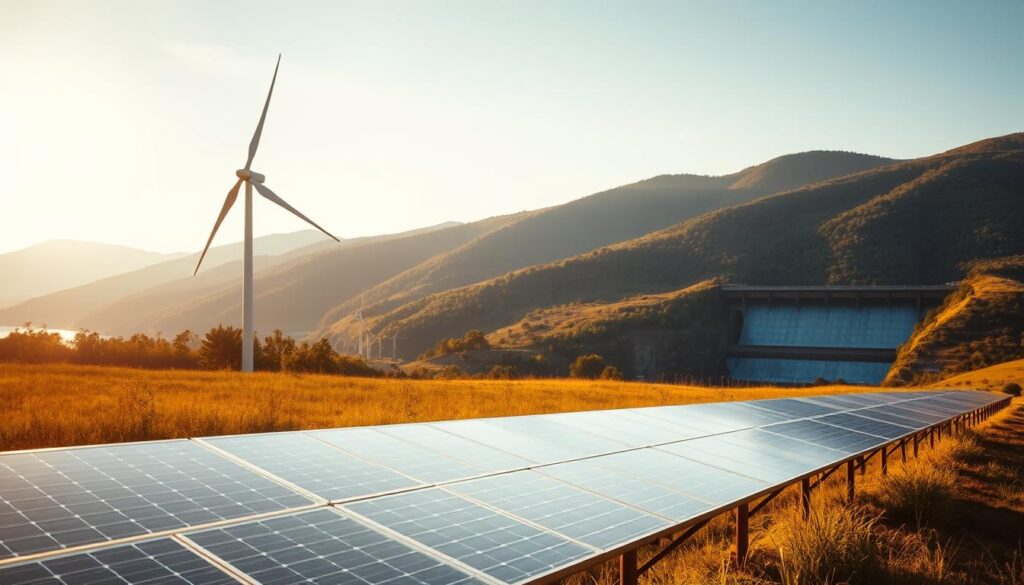
Promoting Social Equity
Sustainable infrastructure promotes social equity by ensuring that all members of the community have access to essential services and opportunities. This includes the development of affordable housing, public transportation, and community facilities.
A notable example of promoting social equity through sustainable infrastructure is the incorporation of sustainable water management practices. By ensuring equitable access to clean water, communities can reduce health disparities and improve overall quality of life.
| Aspect | Traditional Infrastructure | Sustainable Infrastructure |
|---|---|---|
| Energy Source | Fossil Fuels | Renewable Energy |
| Water Management | Conventional Drainage | Sustainable Water Management |
| Public Spaces | Limited Green Spaces | Accessible Public Parks |
Creating Accessible Public Spaces
The creation of accessible public spaces is another critical social impact of sustainable infrastructure. Parks, public transportation hubs, and community centers that are designed with accessibility in mind foster a sense of community and social inclusion.
By prioritizing the development of such spaces, cities can promote social interaction and a sense of belonging among residents, regardless of their background or socioeconomic status.
Technology’s Role in Sustainable Infrastructure
Technology plays a crucial role in modern sustainable infrastructure, enabling more efficient use of resources. By integrating cutting-edge technology, we can optimize energy use, reduce waste, and minimize water consumption.
Smart Cities: Integrating Technology
The concept of smart cities has emerged as a key component in sustainable infrastructure development. By leveraging technologies such as IoT sensors, data analytics, and smart grids, cities can enhance the quality of life for their residents while reducing environmental impact.
Smart grids, for instance, improve the efficiency of electricity distribution, allowing for real-time management of energy supply and demand. This not only reduces energy waste but also enables the integration of renewable energy sources into the grid.
Advancements in Renewable Energy
Advancements in renewable energy technologies are crucial for reducing our reliance on fossil fuels and mitigating climate change. Innovations in solar, wind, and hydroelectric power are making these sources more efficient and cost-effective.
The development of energy storage technologies is also playing a vital role in the widespread adoption of renewable energy. By addressing the intermittency of renewable sources, energy storage enables a more stable and reliable energy supply.
Innovative Materials and Practices
The use of innovative materials and construction practices is another area where technology is driving sustainability in infrastructure. New materials and techniques are being developed to reduce the environmental footprint of construction projects.
For example, the use of recycled materials, low-carbon concrete, and sustainable timber can significantly reduce the environmental impact of building projects. Additionally, modular construction techniques can minimize waste and improve construction efficiency.
Policy and Regulation Framework
Governments worldwide are recognizing the need for robust policy frameworks to support eco-friendly development. As the world shifts towards more sustainable practices, the role of policy and regulation in shaping the future of infrastructure becomes increasingly important.
The policy and regulation framework is crucial for the successful implementation of sustainable infrastructure projects. It encompasses various elements, including current legislation, building codes, and incentives for green infrastructure.
Current Legislation Supporting Sustainability
Current legislation plays a vital role in promoting sustainability. Governments are enacting laws and regulations that encourage the development of green infrastructure. For instance, policies that support renewable energy sources, such as solar and wind power, are becoming more prevalent. Discover the latest trends in green to understand how legislation is driving change.
Some key legislative measures include:
- Tax incentives for companies investing in renewable energy.
- Grants for research and development in sustainable technologies.
- Regulations that mandate the use of sustainable materials in construction.
Building Codes and Standards
Building codes and standards are essential for ensuring that infrastructure projects meet certain sustainability criteria. These codes often include specifications for energy efficiency, water conservation, and the use of sustainable materials.
| Building Code Aspect | Description | Benefit |
|---|---|---|
| Energy Efficiency | Standards for reducing energy consumption. | Lower operational costs. |
| Water Conservation | Measures for reducing water usage. | Conservation of natural resources. |
| Sustainable Materials | Specifications for using eco-friendly materials. | Reduced environmental impact. |
Incentives for Green Infrastructure
Incentives are a powerful tool for encouraging investment in green infrastructure. Governments and financial institutions are offering various incentives, such as green bonds and sustainability-linked loans, to attract investors.
Key incentives include:
- Green bonds that specifically fund eco-friendly projects.
- Public-private partnerships (PPPs) that share the risks and rewards of infrastructure development.
- Sustainability-linked loans that offer favorable terms for projects meeting certain sustainability criteria.
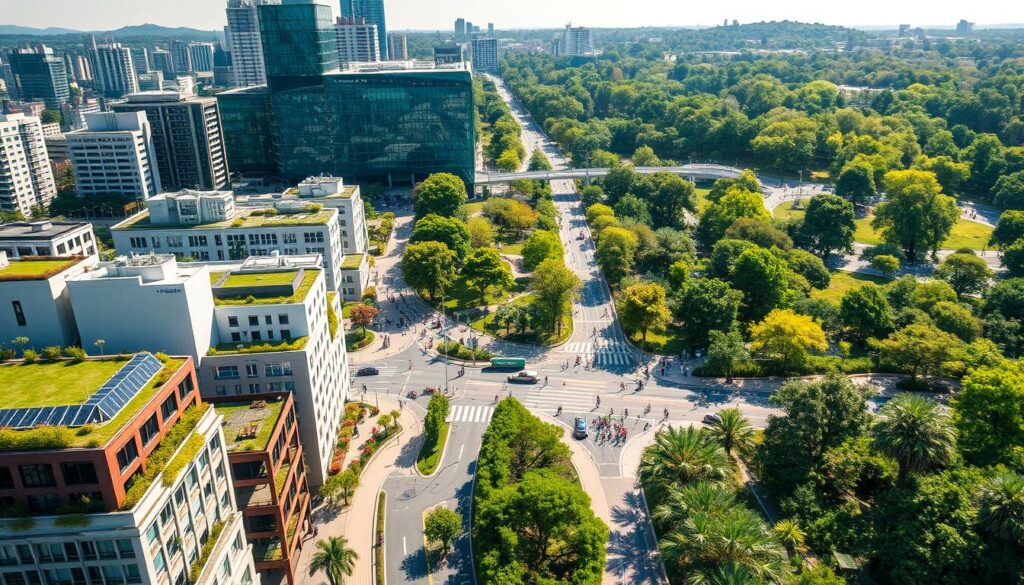
By understanding and leveraging these policy frameworks, we can accelerate the transition to a more sustainable and resilient world.
Case Studies: Successful Sustainable Projects
Sustainable infrastructure is key to creating resilient cities, and various projects around the world are showcasing how this can be achieved effectively. By examining successful case studies, we can gain insights into the design, implementation, and impact of such projects.
The High Line in New York City
The High Line is an elevated park built on a historic freight rail line, demonstrating innovative reuse of urban infrastructure. This project has not only revitalized the surrounding neighborhood but also set a precedent for urban renewal projects globally. The High Line incorporates sustainable design elements, such as native plant species and efficient irrigation systems, minimizing its environmental footprint.
For more information on sustainable infrastructure projects, visit Climate Impact to explore a variety of initiatives.
The Bosco Verticale in Milan
The Bosco Verticale, or Vertical Forest, is a pair of residential towers in Milan that integrate extensive greenery into their design. This project enhances biodiversity, improves air quality, and provides residents with a unique living environment. The Bosco Verticale is a prime example of how urban development can be balanced with environmental stewardship.
Masdar City in Abu Dhabi
Masdar City is a planned city project that aims to be a model for sustainable urban development. It incorporates renewable energy infrastructure, such as solar power, and features energy-efficient buildings. Masdar City is designed to be a zero-carbon, zero-waste city, showcasing the potential for sustainable infrastructure in challenging environments.
Leading civil engineering firms, such as those listed on World Civil Society, are often behind such innovative projects, bringing expertise in sustainable infrastructure development.
| Project | Location | Key Features |
|---|---|---|
| The High Line | New York City | Innovative reuse of urban infrastructure, native plant species, efficient irrigation |
| The Bosco Verticale | Milan | Extensive greenery, enhances biodiversity, improves air quality |
| Masdar City | Abu Dhabi | Renewable energy infrastructure, energy-efficient buildings, zero-carbon goal |
Financing Sustainable Infrastructure Development
The global push for sustainable development necessitates innovative financing solutions for infrastructure. As the world grapples with the challenges of climate change, urbanization, and resource depletion, the need for sustainable infrastructure has become increasingly evident.
According to the United Nations Environment Programme (UNEP), the world needs an estimated $94 trillion in infrastructure investments by 2040 to meet the demands of a growing population and to support sustainable development goals. “Financing sustainable infrastructure is not just about allocating funds; it’s about creating a sustainable future,” said Erik Solheim, the former Executive Director of UNEP.
Public-Private Partnerships
One of the key strategies for financing sustainable infrastructure development is through public-private partnerships (PPPs). PPPs allow governments to collaborate with private sector entities to finance, develop, and operate infrastructure projects. This model not only brings in much-needed capital but also introduces efficiency and innovation in project execution.
For instance, the sustainable transportation systems project in Singapore was successfully implemented through a PPP, combining government oversight with private sector expertise to deliver a world-class transportation network.
Grants and Funding Opportunities
Grants and funding opportunities from governmental and non-governmental organizations play a crucial role in supporting sustainable infrastructure projects. These funds can be used for various purposes, including research and development, project implementation, and capacity building.
- The Green Climate Fund (GCF) provides significant financial support for projects aimed at mitigating climate change.
- The World Bank’s Infrastructure Financing Facility offers financing for infrastructure projects in developing countries.
Crowdfunding for Infrastructure Projects
Crowdfunding has emerged as an innovative financing mechanism for infrastructure projects. By leveraging online platforms, project developers can raise funds from a large number of people, typically in exchange for rewards or equity.
Sustainable construction practices are being promoted through crowdfunding platforms, where projects focusing on green buildings and renewable energy are attracting significant interest from individual investors.
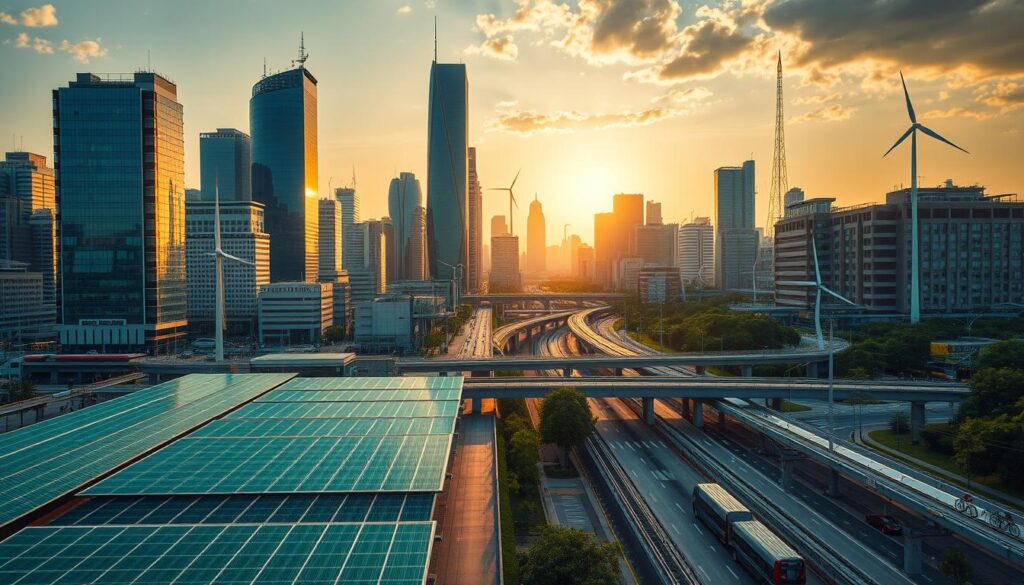
As the world continues to urbanize and grapple with environmental challenges, the importance of financing sustainable infrastructure cannot be overstated. By exploring diverse financing options and fostering collaboration between public and private sectors, we can accelerate the transition towards a more sustainable and resilient future.
Community Engagement in Infrastructure Planning
Community engagement plays a pivotal role in shaping infrastructure that meets local expectations. By involving the community in the planning process, developers can ensure that projects are not only sustainable but also align with the needs and aspirations of the local population.
Stakeholder Involvement
Stakeholder involvement is a critical component of community engagement. It involves identifying and engaging with individuals and groups who have a vested interest in the infrastructure project. This can include local residents, businesses, community groups, and government agencies. Effective stakeholder involvement helps to build support for the project, identify potential issues early, and foster a sense of ownership among community members.
According to a report by Pew, community engagement helps drive much-needed infrastructure by ensuring that projects are tailored to the community’s needs.
Importance of Public Feedback
Public feedback is essential for understanding the community’s needs and concerns. It provides valuable insights that can inform the planning process, ensuring that the infrastructure developed is responsive to community needs. Public feedback mechanisms can include surveys, public meetings, and online engagement platforms.
Building Trust and Transparency
Building trust and transparency is fundamental to successful community engagement. This involves being open about the planning process, the decisions made, and the rationale behind them. Transparency helps to foster trust among community members, reducing the likelihood of conflict and increasing support for the project.
The following table illustrates the key elements of community engagement in infrastructure planning:
| Element | Description | Benefits |
|---|---|---|
| Stakeholder Involvement | Engaging with individuals and groups affected by the project | Builds support, identifies potential issues early |
| Public Feedback | Gathering insights from the community through various mechanisms | Informs the planning process, ensures responsiveness to community needs |
| Transparency and Trust | Being open about the planning process and decisions | Fosters trust, reduces conflict, increases project support |
By incorporating these elements, infrastructure planning can become more inclusive, responsive, and sustainable, ultimately contributing to the development of sustainable water management and sustainable energy solutions.
Challenges in Implementing Sustainable Infrastructure
Despite its benefits, sustainable infrastructure development encounters several obstacles. The journey towards a greener, more resilient world is complex and multifaceted, involving various stakeholders and requiring significant investment.
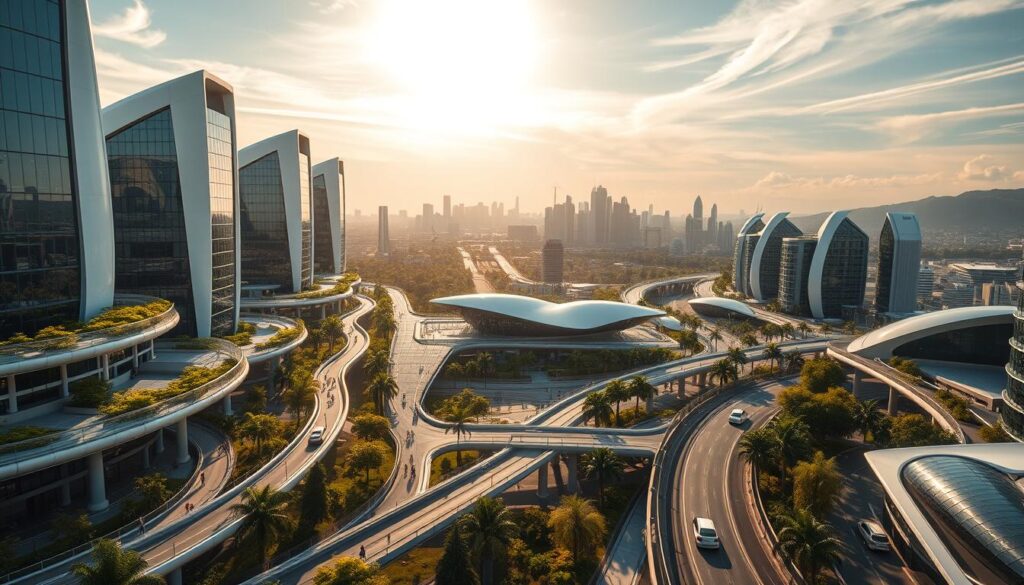
Technical and Financial Barriers
One of the primary challenges is the technical complexity of sustainable infrastructure projects. These projects often involve cutting-edge technology and innovative materials, which can be costly and difficult to implement. For instance, integrating renewable energy sources into existing grids requires advanced technologies and sophisticated management systems.
Financial barriers also pose a significant challenge. Sustainable infrastructure projects typically require substantial upfront investments, which can be a deterrent for investors. However, exploring innovative financing models and public-private partnerships can help mitigate these costs.
Key financial challenges include:
- High initial investment costs
- Limited access to capital for green projects
- The need for specialized financial instruments
Resistance to Change
Resistance to change is another significant hurdle. Stakeholders, including policymakers, investors, and the general public, may be hesitant to adopt new technologies or practices due to concerns about cost, effectiveness, or unfamiliarity.
To overcome this resistance, it is crucial to educate stakeholders about the long-term benefits of sustainable infrastructure, such as cost savings, improved public health, and enhanced quality of life. Engaging communities in the planning process can also foster support and acceptance.
Balancing Development and Preservation
Balancing development with preservation is a delicate task. Sustainable infrastructure development must be achieved without compromising the natural environment or displacing communities. This requires careful planning, environmental impact assessments, and the incorporation of green spaces into urban planning.
Strategies for achieving this balance include:
- Conducting thorough environmental impact assessments
- Incorporating green infrastructure into urban planning
- Engaging with local communities to understand their needs and concerns
By addressing these challenges and adopting a collaborative, forward-thinking approach, we can overcome the obstacles to sustainable infrastructure development and create a more sustainable, resilient future.
Future Trends in Sustainable Infrastructure
Sustainable infrastructure is on the cusp of a revolution, driven by the adoption of circular economy concepts and climate-resilient designs. As cities continue to grow and face the challenges of climate change, the need for innovative and sustainable infrastructure solutions has never been more pressing.
Circular Economy Concepts
The circular economy represents a significant shift in how we approach infrastructure development. By designing systems that are restorative and regenerative by design, we can reduce waste and promote the efficient use of resources. This approach is gaining traction in green infrastructure projects, where materials are chosen for their sustainability and recyclability.
Climate-Resilient Infrastructure
As the impacts of climate change become more pronounced, the importance of climate-resilient infrastructure cannot be overstated. This involves designing infrastructure that can withstand extreme weather events and adapt to changing environmental conditions. According to a report by PwC on global infrastructure trends, incorporating climate resilience into infrastructure planning is crucial for long-term sustainability.
| Trend | Description | Benefits |
|---|---|---|
| Circular Economy | Designing infrastructure with recyclable materials and minimal waste | Reduced environmental impact, cost savings |
| Climate Resilience | Infrastructure designed to withstand extreme weather events | Enhanced durability, reduced maintenance costs |
| Urban Agriculture | Incorporating agricultural practices into urban planning | Increased food security, community engagement |
The Role of Urban Agriculture
Urban agriculture is emerging as a vital component of sustainable urban planning. By integrating agricultural practices into urban landscapes, cities can enhance food security, reduce carbon footprints, and create community spaces. This trend is expected to continue growing as cities look for innovative ways to address environmental and social challenges.
In conclusion, the future of sustainable infrastructure is being shaped by a combination of circular economy principles, climate-resilient designs, and innovative practices like urban agriculture. As these trends continue to evolve, they will play a crucial role in creating a more sustainable and resilient built environment.
The Importance of Maintenance and Upgrades
Maintenance and upgrades are pivotal for the longevity and effectiveness of sustainable infrastructure projects. As the world shifts towards renewable energy infrastructure and climate-resilient infrastructure, ensuring that these projects remain efficient and effective over time is crucial.

Ensuring Longevity of Sustainable Projects
To maximize the lifespan of sustainable infrastructure, regular maintenance is essential. This involves:
- Routine inspections to identify potential issues before they become major problems.
- Timely repairs and replacements of components to prevent deterioration.
- Upgrades to incorporate new technologies and improve efficiency.
By adopting a proactive maintenance approach, infrastructure owners can significantly extend the life of their projects, ensuring they continue to deliver benefits over the long term.
Regular Assessment Strategies
Regular assessments are vital for identifying areas that require maintenance or upgrades. Effective strategies include:
- Conducting annual performance reviews to assess the infrastructure’s condition and efficiency.
- Utilizing advanced monitoring technologies to track performance in real-time.
- Engaging with stakeholders to gather feedback and insights on infrastructure performance.
As experts emphasize, “Regular assessments not only help in maintaining the infrastructure but also in planning for future upgrades and improvements.”
Integrating Upgrades in Planning
Integrating upgrades into the initial planning phase of sustainable infrastructure projects is a forward-thinking approach that can significantly enhance their longevity and effectiveness. This involves:
- Designing infrastructure with flexibility to accommodate future upgrades.
- Incorporating modular components that can be easily replaced or upgraded.
- Planning for potential future needs and technologies.
“The key to successful sustainable infrastructure lies in its ability to adapt and evolve over time. By integrating upgrades into the planning phase, we can ensure that our infrastructure remains resilient and efficient in the face of changing environmental and technological landscapes.”
By focusing on maintenance and upgrades, we can ensure that sustainable infrastructure projects continue to contribute to a greener, more resilient world.
Global Cooperation for Sustainable Infrastructure
The need for global cooperation in sustainable infrastructure cannot be overstated. As the world grapples with the challenges of climate change, environmental degradation, and social inequality, collaborative efforts on a global scale are essential for achieving sustainable development goals.
International Frameworks and Agreements
International frameworks and agreements play a crucial role in promoting sustainable infrastructure globally. Initiatives such as the Paris Agreement and the United Nations’ Sustainable Development Goals (SDGs) provide a foundation for countries to work together towards common sustainability objectives. These frameworks encourage the adoption of sustainable construction practices and the development of sustainable transportation systems, which are critical for reducing carbon emissions and enhancing environmental quality.
Exchange of Best Practices
The exchange of best practices among nations and organizations is vital for advancing sustainable infrastructure. By sharing knowledge and experiences, countries can learn from each other’s successes and challenges, thereby accelerating their own sustainable development journeys. This exchange can cover a wide range of areas, including innovative sustainable construction practices and the implementation of efficient sustainable transportation systems.
Role of NGOs and Community Organizations
Non-governmental organizations (NGOs) and community organizations are key stakeholders in the pursuit of sustainable infrastructure. They play a vital role in raising awareness, advocating for sustainable policies, and implementing projects that benefit local communities. Their involvement ensures that sustainable infrastructure development is inclusive, equitable, and responsive to the needs of all stakeholders.
In conclusion, global cooperation is fundamental to the success of sustainable infrastructure initiatives worldwide. Through international frameworks, the exchange of best practices, and the active participation of NGOs and community organizations, we can create a more sustainable, resilient, and equitable world.
Education and Awareness in Sustainability
Education is the cornerstone of sustainability, empowering individuals and communities to adopt greener practices. By integrating sustainability into educational curricula, we can foster a deeper understanding of environmental issues and promote sustainable living.
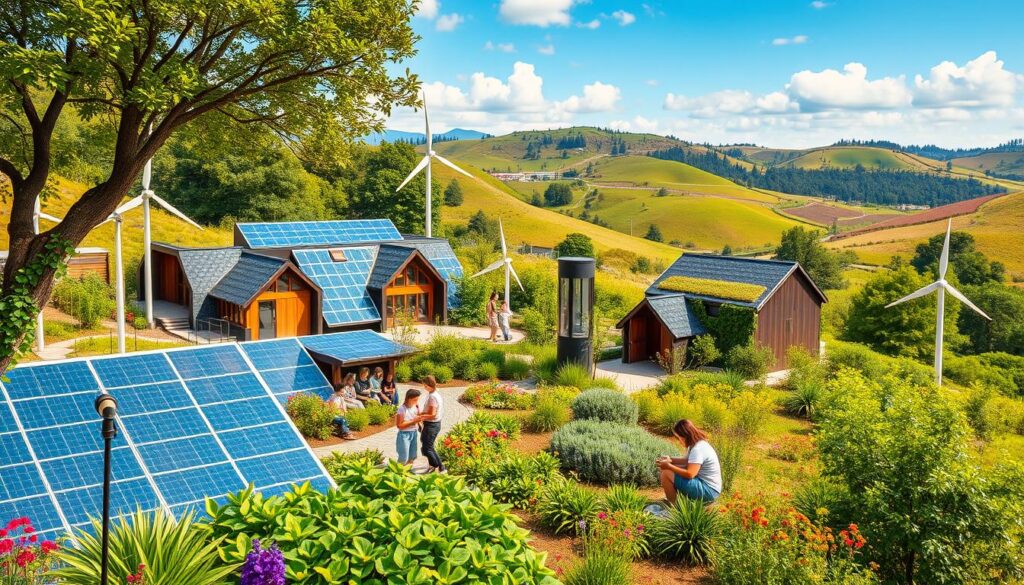
Promoting Sustainable Practices
Promoting sustainable practices through education involves teaching individuals about the importance of sustainable water management and sustainable energy solutions. This can be achieved through various initiatives, such as:
- Workshops on reducing carbon footprint
- Community projects for renewable energy adoption
- Educational materials on sustainable living practices
Educational Programs and Resources
Educational programs play a crucial role in sustainability by providing resources and knowledge on sustainable practices. These programs can range from:
- School curricula that include environmental education
- Online courses on sustainable development
- Community workshops on sustainable gardening and resource conservation
By making these resources accessible, we can empower more individuals to make sustainable choices.
Engaging the Next Generation
Engaging the next generation is critical for the long-term success of sustainability efforts. Educational institutions can play a pivotal role by:
- Incorporating sustainability into school curricula
- Encouraging project-based learning on sustainability topics
- Fostering a culture of environmental stewardship among students
This not only educates young people about sustainability but also inspires them to become active participants in creating a more sustainable future.
Concluding Thoughts on Sustainable Infrastructure
Investing in sustainable infrastructure development is crucial for a resilient, efficient, and prosperous future. As discussed, it encompasses not just environmental benefits but also economic and social advantages.
Moving Forward
The path forward involves integrating sustainable practices into every aspect of infrastructure development. This includes adopting renewable energy sources, using innovative materials, and promoting social equity. For more insights on sustainable infrastructure, refer to resources like the Cambridge Institute for Sustainability Leadership.
Local Action and Collective Responsibility
Encouraging local action and emphasizing collective responsibility are key to promoting sustainable infrastructure. Communities must work together with policymakers and stakeholders to drive change. By doing so, we can create a more sustainable and equitable world.
